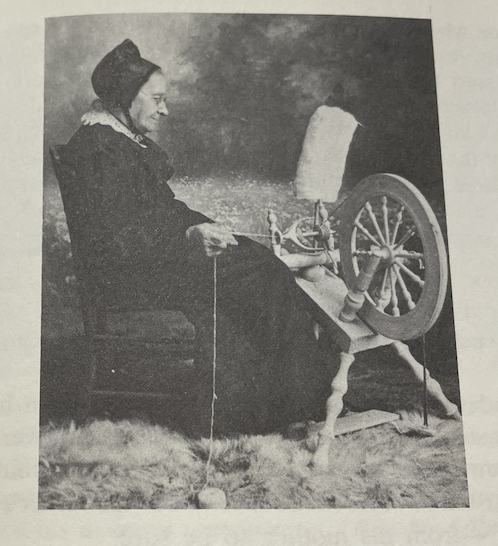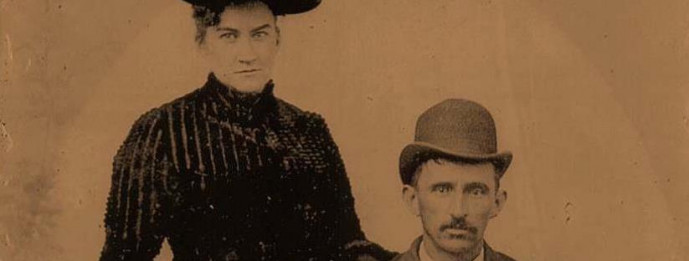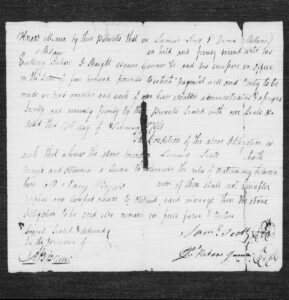What is a Marriage Bond? Posted on October 21, 2025
- October 21, 2025
- |
- Posted By: Scott Family Collection
A marriage bond is a written statement of intent to marry. Such documents were in common use in North Carolina counties before 1868 when the authority to record marriages was transferred to the Register of Deeds. After that date, the only public record of a marriage was the marriage license.
Before 1868, folks getting married would post a marriage bond. That is, the prospective groom had that responsibility.
To acquire a marriage bond, the prospective groom and one or more bondsmen agreed to forfeit a sum of money if for some reason the marriage did not take place. One reason for a marriage not being possible might be that one or both of the parties was/were already married. Another barrier might be the existence of consanguinity, which occurred when the prospective bride and groom were too closely related.
You can find the names of the prospective groom and prospective bride on the bond, but the parents were not typically included. Marriage bonds were filed in the county of the bride’s residence. Also included were the names of the bondsman or bondsmen and the witness or witnesses.
While working on the Scott Family genealogy, I came across the marriage bond for Samuel Scott and Nancy Bryan(t) Scott. The document was hand written and dated February 17, 1794. Nancy’s last name seems to have a little extra mark, possibly the letter “t.”
In 1794, when Samuel and Nancy decided to marry, Samuel was thirty years old and Nancy was twenty one.
At that time, Samuel was required to file a marriage bond in the amount of four hundred pounds. We don’t use pounds as currency any more, but even so, this seems like a huge amount of money. Samuel’s bondsman was James Mebane. The witness was someone named A. B. Bruce.
Here is an image of the marriage bond between Samuel and Nancy.
Busy as a Bee in a Bustle, posted on September 30, 2025
- September 30, 2025
- |
- Posted By: Scott Family Collection


I was browsing the website of the Alamance County Historical Museum recently and came across a photograph of a dress made around 1870. The dress was labeled as green moire silk and it sported a bustle. I have always wondered how women who wore such things sat down. Did they simply perch on the edge of their seats? Did they push the bustle to one side? Or did they only wear such dresses standing up?
I contacted the museum and asked if I could reproduce a photo of the dress. They agreed, so here it is and here is their image credit: reproduced with permission from the Alamance County Historical Museum.
As it turns out, the dress was owned by Frusannah Kime Sellars. See the black and white image of her below the image of her dress. She appears to be in costume, as the photo was taken around 1918. I think by then, bonnets such as she is wearing might not have been in style. Her grandson B. Everett Jordan was in textiles, so this might have been to do with that.
Frusannah was born in 1833 and died in 1922 at the age of 89. She and her husband, Dr. Benjamin Abel Sellars had 11 children-7 sons and 4 daughters.
Thirty six years after Frusannah died, the lives of two of her grandchildren would intersect in a very significant way on the very same day. And here is how it happened:
On Thursday, April 17, 1958, Governor Luther Hodges traveled by limousine from Raleigh to Haw River, to visit one of Frusannah’s and Benjamin’s grandchildren, Mary White Scott. The occasion was a sad one, as he was bringing his condolences to Mary, whose husband US Senator W. Kerr Scott had died the day before in Alamance General Hospital.
When the Governor’s driver, Harold Minges, pulled into Senator Scott’s driveway, they were told that Miss Mary as she was called, was not there. She was at Hawfields Presbyterian Church, selecting the plot that would be Kerr’s final resting place. Mary’s mission was urgent; the funeral would be the very next day.
After visiting with “Miss Mary” as she was called, Governor Hodges traveled to Saxapahaw to visit with B. Everett Jordan. After much deliberation, Governor Hodges had decided to appoint B. Everett Jordan to fill the last two years of Kerr Scott’s term in the Senate. Mr. Jordan was a successful mill owner; his factory made textiles. Despite his busy schedule, B. Everett Jordan was ready to accept Governor Hodges’ offer. B. Everett was interested in a career in politics and planned to run for the Senate after his two year term expired. He went on to serve in the Senate from 1958 to 1973.
Mrs. Scott and Mr. Jordan were related; they were first cousins which meant that Frusannah Kime Sellars was the grandmother for both of them.
I Am Going to Sit Right Down and Write Myself a Letter, Posted on September 25, 2025
- September 25, 2025
- |
- Posted By: Scott Family Collection
Do you have a favorite pen or writing instrument? I do.
My favorite is a fountain pen I bought years ago in a shop in Chapel Hill, North Carolina. The pen, a handsome Pelikan in black and green with a gold nib, sits on my desk at the Scott Family Collection.
By now, my Pelikan is old enough to qualify as a relic, and I was tempted to include it in the display case for our next exhibit, From Desk to Desk, A Journey Told in Letters. The in-house display includes various hand written letters, envelopes, dip pens, ink pots, and two handsome writing desks all testaments to how hard you had to work to communicate in the 1800s. Before the fountain pen took off, letters were written with ink, usually iron gall ink, and dip pens.
I have discovered that in the past, letters were often exchanged, that is, included in the envelope with a new letter. I also noticed that in many cases, the sender would give careful instructions about what parts of the enclosed letter to share and which portions to keep confidential. Of course, the reader must have been tempted to read out the confidential parts. They were often much more interesting and in some cases, hilarious!
But I digress. Back to the fountain pen.
I still don’t know why I wanted that pen. I was in graduate school at the time and spent most of my waking moments peering through microscopes at extremely tiny creatures who had no awareness of me or how much my degree depended on them.
A fountain pen is a messy thing. I do not recommend storing it in a shirt pocket, although the cap does have a cute clip in the shape of a pelican’s bill. Filling a fountain pen involved dipping it into a bottle of ink and pulling up a small amount into the pen’s reservoir. Even if you do this maneuver successfully, there is always the chance you will get ink all over your fingers when you use the pen to write.
As it turned out, my fountain pen came in handy when I was brushing up on my German. Back then you had to show proficiency in a foreign language to get your degree. I had brief encounters with French and Latin, but German was the only foreign language I had any hope of passing a test in. I used the pen to write out words and sentences, trying to renew my acquaintance with a language I had not studied in a very long time.
I took German, starting in junior high school. The curriculum at that time expected the student to learn German the way children learn languages, that is by hearing it spoken. We were not allowed to see the words printed on paper until about half way through the first year. The odd sounds crystallized for me at that moment. It did not hurt that in German, the nouns are capitalized. That was my light bulb moment and I loved German and German pens ever since.
A Painful Task: The Condolence Letter, Posted September 8, 2025
- September 8, 2025
- |
- Posted By: Scott Family Collection
Some years back, during COVID, when it became clear that I would be working remotely for quite some time, I looked around for a project that could be completed at home. I knew that the Scott Family Collection housed a large number of letters, mostly personal, but some documenting business transactions, and these letters were a window into a lost time. One summer, I even opened the boxes and listed the contents, recording the writer, the intended recipient, and the date, hoping to get back to them.
Reading someone else’s mail is a guilty pleasure. You learn their innermost thoughts and find out about their daily lives. Some letters are very funny, full of anecdotes and foibles.
Mostly, this is an enjoyable task. Shared meals, trips taken, pleasant visits to relatives, all add to our understanding of a person’s life. I especially enjoyed reading about family gatherings to enjoy a grape harvest, or a Sunday afternoon ice cream party.
However, sometimes you come across a condolence letter. These letters are written for a specific purpose, that is, to acknowledge a death.
Today, when someone dies, we tend to just send a card, or a text, or even an email to convey our sympathy. You can even leave notes on the funeral home’s website, for all the world to see in perpetuity. But in the past, before all of these modern conveniences, people had to put pen to paper and arrange their thoughts on the page. A painful task.
Over time, I started to see patterns. The writer often asked to be excused for not writing sooner. They had only heard about the loss recently. Then they convey sympathy, expressing how much grief they feel individually and of course, share with the mourner.
Then they would write something about the deceased. How much they enjoyed their company. How promising they were, if young. For the loss of someone of advanced age, the comments might include how blessed a relief the end must have been when it finally came.
If the writer was a believer, they would often quote a Bible passage, sharing trust in God, comfort in their faith, assurances of how we would all see each other some day.
I was struck by this sort of absolute assurance when I worked at a divinity school. The dean said to a gathering of graduands that it was wonderful to be together, to spend time together, and that except for graduation this would be the last time we were all together before the Kingdom. It was a poignant moment, acknowledging the necessity of change and loss but hopeful and uplifting as well. I never forgot it.




